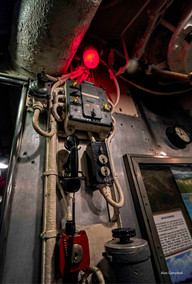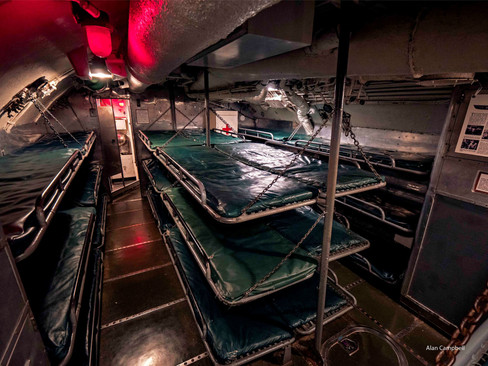Submarines are Cool: USS Silversides
- Alan Campbell
- Oct 14, 2022
- 4 min read
I geek out when I have the chance to tour a submarine.
I visited Hawaii six years ago during the 75th anniversary of the attack on Pearl Harbor. While there, I took advantage of the opportunity to tour the USS Bowfin, permanently displayed on the harbor grounds.

There’s a real beauty to the metal and bronze inside a submarine. The way it all twists, turns and intertwines is a work of art.
Also, of course, I can’t imagine what it was like to serve on a submarine, spending up to seven weeks at a time out at sea in such cramped quarters with 59 other officers and crew.
All of that is the long way of explaining why I couldn’t pass up the opportunity to visit the USS Silversides on a recent trip to Muskegon, Michigan.
The Silversides isn’t just any World War II submarine. She is the most famous WWII submarine still surviving today.

She sunk more ships, sinking 30 Japanese vessels and damaging 14 others, third most of any allied WWII submarine, and took down more tonnage than any other surviving submarine from that war. Along the way she also rescued two American pilots and performed the first-ever appendectomy aboard a submarine.
You read that right, an appendectomy, on a dining room table.
A sailor on board the Silversides, George Platter, suffered a severe appendicitis attack while the submarine was out to sea. There were no doctors on board. The closest they had was Pharmacist Mate Thomas Moore whose main duty up until then wasn’t much more than handing out aspirin.
But Moore had a book on how to perform the procedure, there wasn’t anyone else jumping up to volunteer to do it, and he told the Captain he believed he could.

So they cleared off a dining table, gave Platter ether as an anesthetic to knock him out and went to work using tools fashioned out of kitchen utensils.
Understandably, the procedure took longer than it might normally be expected, what with a Pharmacist Mate having to refer to a book along the way. The patient even began to wake up before it was all done but, in the end, everything was somehow pulled off successfully and Platter reportedly lived a long and healthy life.
Silversides’ first patrol set sail out of Pearl Harbor on April 4, 1942, just five months after the Japanese attack there. She went on 14 patrols in total, continuing through the end of the war in 1945. Along the way she patrolled throughout the Pacific including the Solomon, Marianas and Caroline Islands, Guam, Australia and, yes, Japan.
The submarine received 12 battle stars for her service and was awarded a Presidential Unit Citation.

Silversides also has a bit of Hollywood associated with her. She was depicted along with other ships in the movie Destination Tokyo starting Cary Grant and the 2002 film Below used exterior shots of her. She was towed around Lake Michigan for filming on that one.
(Little sidenote, also appearing in Destination Tokyo was Alan Hale Sr., the father of Alan Hale Jr. The junior Hale was a pretty famous Skipper himself, aboard the fateful ship that ran aground on Gilligan’s Island.)
There are a lot of video clips about the Silversides on the museum website, including a 1950s era black-and-white telling of The Silversides Story. It features the over-the-top drama that was typical of films from that period but it’s still a fun watch and gives a decent feel for what it was like on board:
For all its glory, and the action it saw, only one sailor lost his life during the Silversides patrols.
The submarine was on the surface when it was attacked by a Japanese guard boat. During the 75-minute battle that ensued, the Silversides heavily damaged the Japanese boat but Torpedoman’s Mate Third Class Mike Harbin was hit and killed by an enemy machine gun bullet. A plaque on the Silversides deck commemorates Harbin still today.
Museum and Touring Silversides
The USS Silversides tour begins in the Submarine Museum, a large two-story building telling the story of Pearl Harbor and filled with a wealth of submarine memorabilia. There’s also a recreation of a Nazi POW camp and other World War II-related displays.

In addition, there are special, rotating, exhibits including recent ones about veterans from the surrounding Lake Michigan area and another about women serving in the Army Nurse Corps.
I highly recommend taking the time to watch the film about the Silversides shown in a small theater near the front of the museum. It’s a walk-through of the submarine and really helps you understand what you are seeing as you tour the Silversides.
The submarine tour is entirely self-guided. A little tip, I arrived shortly after the museum opened in the morning on a Friday in October, when school is in session and the number of vacationers in the Lake Michigan area is relatively small compared to the warmer months.
I took my time wandering through the museum and several other people did show up while I was there. Even so, when I went on board the submarine after completing the museum tour, I had it all to myself. I didn’t even hear anyone else until I was nearing the end, providing me the time to really experience the visit without distraction.
USCGC McLane W-146
The Silversides is not the only ship at the museum. Docked just a few yards away is the US Coast Guard’s McLane patrol boat.

The McLane was part of a group of 33 ships authorized by President Calvin Coolidge to enforce the Volstead Act. You might recognize that more by its other name, the Prohibition Act.
From 1928 to 1931, she was stationed at San Pedro, California, and then Unalaska, Alaska.
When World War II broke out, the McLane was used to patrol the Bering Sea off the coast of Alaska against enemy attack.
In 1942, working with another Navy patrol craft, the McLane came in contact with a Japanese submarine. The two patrol crafts dropped depth charges and eventually oil bubbles were seen rising to the surface.
It’s believed the submarine was sunk that day but there continues to be some question, including speculation that it might have even been a Soviet submarine.
The McLane is also open for visitors to walk through and inspect.
_________________
**I allow use of my photos through Creative Commons License. I'm not looking to make money off this thing. I only ask you provide me with credit for the photo by noting my blog address, alansheaven.com, or a link back to this page.















































Comments